 After the storm of 1987, Cutler´s was heavily replanted with ash, black walnut and wild cherry. Plastic tree shelters were used to protect these trees against deer browsing and rabbit / grey squirrel damage. These tree shelters were meant to biodegrade with time but unfortunately they have steadfastly refused to do just this. The consequence of this is that we now, over twenty years later, are faced with the cleaning up of these seemingly many thousands of shelters, both from the ground, if they split and fell off as they were supposed to, or worse still, off the tree if still attached to the stem of the tree. In the case of those still attached to the stems, they are a collection point for water, which rots the bark, or all manner of other things which fall down the tube - we even found a dead squirrel stuck down one shelter. The clean up has until now taken all winter and we are still nowhere near finished. We think it may take years still to eventually clear up last shelter. Perhaps the moral of the story here is "Never believe what´s on the label".
After the storm of 1987, Cutler´s was heavily replanted with ash, black walnut and wild cherry. Plastic tree shelters were used to protect these trees against deer browsing and rabbit / grey squirrel damage. These tree shelters were meant to biodegrade with time but unfortunately they have steadfastly refused to do just this. The consequence of this is that we now, over twenty years later, are faced with the cleaning up of these seemingly many thousands of shelters, both from the ground, if they split and fell off as they were supposed to, or worse still, off the tree if still attached to the stem of the tree. In the case of those still attached to the stems, they are a collection point for water, which rots the bark, or all manner of other things which fall down the tube - we even found a dead squirrel stuck down one shelter. The clean up has until now taken all winter and we are still nowhere near finished. We think it may take years still to eventually clear up last shelter. Perhaps the moral of the story here is "Never believe what´s on the label". Some time ago I came across a number of num
 bered corrugated metal sheets and pieces of roofing felt laid out on the ground in a remote part of Cutler´s. I assumed these to be reptile shelters i.e. places where slow worms, lizards and adders would crawl (slither?) under if disturbed. After a little research and e-mailing various reptilely people, I found out that these were part of a reptile survey being carried out by Kent University which has been ongoing for the last four years. They had got a little lost, as they thought they were on the Forestry Commission land of King´s Wood but I think if I can help the survey in any way then I will and the shelters can stay where they are. If you do come across these shelters, please do not disturb them or turn them over as this would disturb the inhabitants.
bered corrugated metal sheets and pieces of roofing felt laid out on the ground in a remote part of Cutler´s. I assumed these to be reptile shelters i.e. places where slow worms, lizards and adders would crawl (slither?) under if disturbed. After a little research and e-mailing various reptilely people, I found out that these were part of a reptile survey being carried out by Kent University which has been ongoing for the last four years. They had got a little lost, as they thought they were on the Forestry Commission land of King´s Wood but I think if I can help the survey in any way then I will and the shelters can stay where they are. If you do come across these shelters, please do not disturb them or turn them over as this would disturb the inhabitants. It was while in the immediate
 area of these reptile shelters, that I recently came across a somewhat mysterious stone. The stone is under some yew trees in the corner of the boundary of Cutler´s Wood and is engraved with the letters "CH". The back of the stone has three flat surfaces and on the top front is a small hollow as shown on the photograph. I have found another worked stone in Cutler´s at a circle of flint stones affectionately known by myself as the Druid´s Circle. What the origins of this stone are and to what (or to whom) "CH" refers is a complete mystery. If anyone has any ideas, I´d be happy to hear them.
area of these reptile shelters, that I recently came across a somewhat mysterious stone. The stone is under some yew trees in the corner of the boundary of Cutler´s Wood and is engraved with the letters "CH". The back of the stone has three flat surfaces and on the top front is a small hollow as shown on the photograph. I have found another worked stone in Cutler´s at a circle of flint stones affectionately known by myself as the Druid´s Circle. What the origins of this stone are and to what (or to whom) "CH" refers is a complete mystery. If anyone has any ideas, I´d be happy to hear them.






